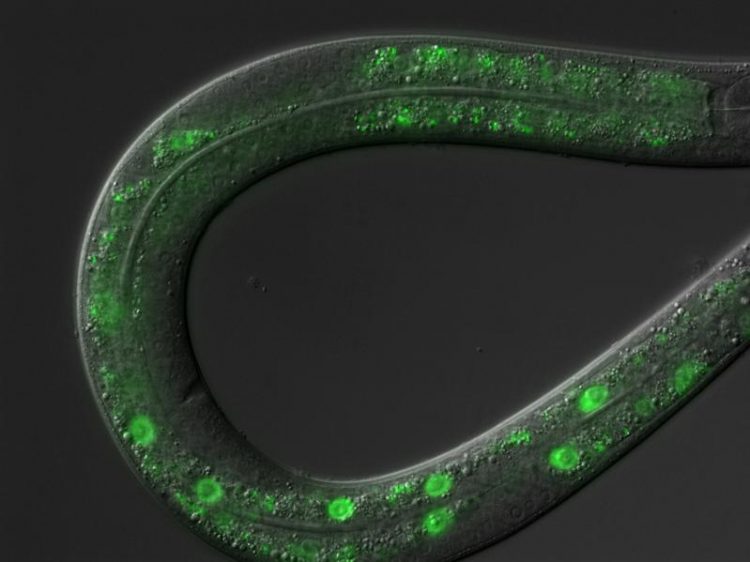A network for longevity

Image of a C. elegans roundworm: green fluorescence labels one of the transcription factors © MPI for Biology of Ageing
An ageing cell goes through major negative changes: defective proteins are not eliminated as they should, mitochondria – the power plants of a cell – do not function properly, the ability to sense nutrients is lost.
All of these defects lead to shortened lifespan. One might think at first glance, they appear to have nothing to do with each other on a molecular level.
“In fact, they are highly interconnected”, says Adam Antebi,Director at the Max Planck Institute for Biology of Ageing in Cologne.
“Now we have found a network of regulators that connects all those different cellular processes.” For their studies the researchers used the roundworm Caenorhabditis elegans, a commonly used model organism in the field of ageing research.
It all began with a scientific finding scientists made already some years ago: Roundworms live much longer if you remove their germ cells – the sperm and egg producing cells. “But we did not know why this happened”, explains Antebi. To answer this question the scientists removed specific genes to test if these worms lost the ability to live long.
If this was the case, the researchers assumed that they found a gene that was normally required to increase the lifespan. In the end the researchers had a list of proteins, which extend lifetime. Many of them belonged to the so-called transcription factors – proteins that reside in the nucleus of the cell to turn on and off other genes.
The detected transcription factors appear to work together. “We found that all these transcription factors regulate and support one another. Actually they behave like a network”, Antebi says.
This network impacts very diverse processes in the worm-cells: the recycling machine, the digestion system and the sensing of nutrients.
“The end-result is changes in metabolism, the process where nutrients become the fuel and building blocks we need”, Antebi explains. With their study the researchers can begin to explain how reproduction, metabolism and life span are intertwined.
Weitere Informationen:
http://www.age.mpg.de/communications/press-pr/press-releases/
http://www.nature.com/ncomms/2016/160322/ncomms10944/full/ncomms10944.html
Media Contact
All latest news from the category: Life Sciences and Chemistry
Articles and reports from the Life Sciences and chemistry area deal with applied and basic research into modern biology, chemistry and human medicine.
Valuable information can be found on a range of life sciences fields including bacteriology, biochemistry, bionics, bioinformatics, biophysics, biotechnology, genetics, geobotany, human biology, marine biology, microbiology, molecular biology, cellular biology, zoology, bioinorganic chemistry, microchemistry and environmental chemistry.
Newest articles

Trotting robots reveal emergence of animal gait transitions
A four-legged robot trained with machine learning by EPFL researchers has learned to avoid falls by spontaneously switching between walking, trotting, and pronking – a milestone for roboticists as well…

Innovation promises to prevent power pole-top fires
Engineers in Australia have found a new way to make power-pole insulators resistant to fire and electrical sparking, promising to prevent dangerous pole-top fires and reduce blackouts. Pole-top fires pose…

Possible alternative to antibiotics produced by bacteria
Antibacterial substance from staphylococci discovered with new mechanism of action against natural competitors. Many bacteria produce substances to gain an advantage over competitors in their highly competitive natural environment. Researchers…





















